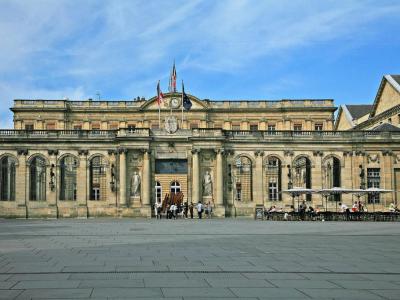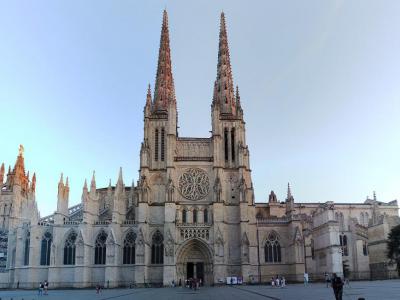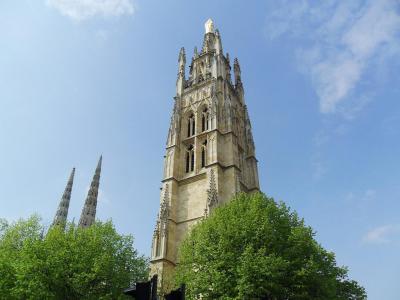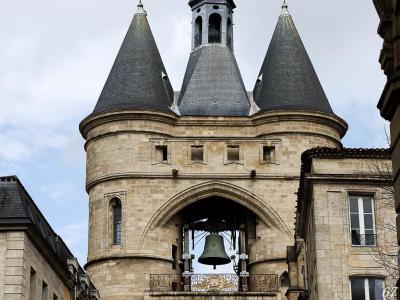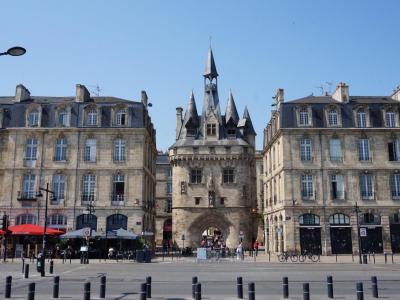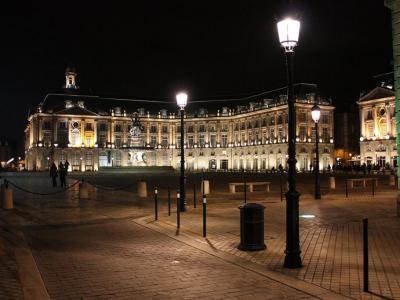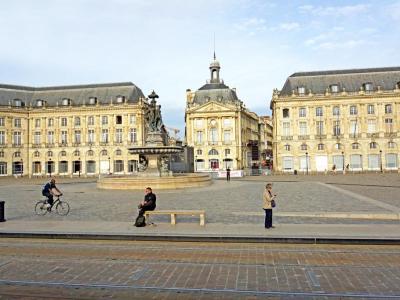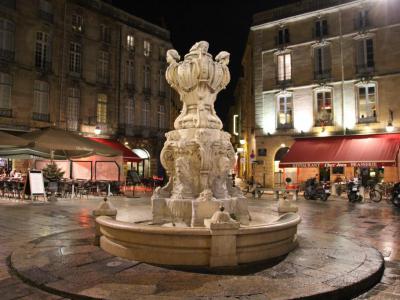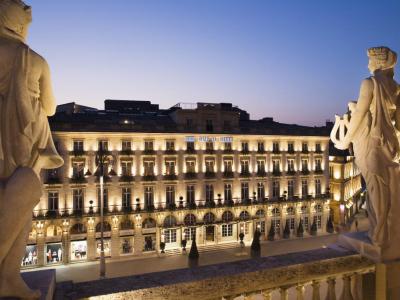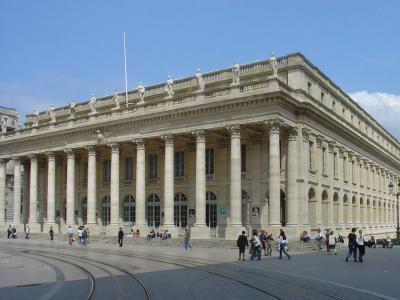Architectural Jewels Walking Tour (Self Guided), Bordeaux
Napoleon Bonaparte referred to Bordeaux as "The Sleeping Beauty" upon seeing its classical architecture when visiting the city. In his turn, Honore de Balzac, the renowned French novelist, impressed by Bordeaux's timeless charm and elegance described it as "an extraordinary town".
Indeed, Bordeaux is one of Europe's most original architectural centers. More recently, the city has been included in UNESCO World Heritage List as "a great urban and architectural ensemble".
Undoubtedly, the main jewel in the architectural crown of Bordeaux is the Cathedral of Saint Andrew (Cathédrale Saint-André), a Gothic masterpiece that has stood here for nearly a millennium. Its intricate facade, stunning stained glass windows, and towering spires can leave anyone in awe.
Also, one cannot pass without notice the imposing Big Bell (Grosse Cloche). Adorned with a charming clock (added in the 18th century), this medieval gate once guarded the city entrance.
Another historical gateway worthy of attention is the Palace Gate (Porte Cailhau), a picturesque showcase of the city's medieval and Renaissance heritage.
The Stock Exchange Square (Place de la Bourse), with its stunning mirror-like water feature and majestic architecture, is a testament to Bordeaux's prosperity during the Age of Enlightenment.
And, of course, the architectural gem of Bordeaux Grand Theatre is a sight to behold. This neoclassical masterpiece in the heart of the city is still busy hosting world-class performances all year round.
Rest assured, the hours of your time dedicated to experiencing these and other architectural marvels in Bordeaux are going to be well spent. This self-guided journey is bound to leave you with a profound appreciation for the city's heritage and a desire to explore even more.
Indeed, Bordeaux is one of Europe's most original architectural centers. More recently, the city has been included in UNESCO World Heritage List as "a great urban and architectural ensemble".
Undoubtedly, the main jewel in the architectural crown of Bordeaux is the Cathedral of Saint Andrew (Cathédrale Saint-André), a Gothic masterpiece that has stood here for nearly a millennium. Its intricate facade, stunning stained glass windows, and towering spires can leave anyone in awe.
Also, one cannot pass without notice the imposing Big Bell (Grosse Cloche). Adorned with a charming clock (added in the 18th century), this medieval gate once guarded the city entrance.
Another historical gateway worthy of attention is the Palace Gate (Porte Cailhau), a picturesque showcase of the city's medieval and Renaissance heritage.
The Stock Exchange Square (Place de la Bourse), with its stunning mirror-like water feature and majestic architecture, is a testament to Bordeaux's prosperity during the Age of Enlightenment.
And, of course, the architectural gem of Bordeaux Grand Theatre is a sight to behold. This neoclassical masterpiece in the heart of the city is still busy hosting world-class performances all year round.
Rest assured, the hours of your time dedicated to experiencing these and other architectural marvels in Bordeaux are going to be well spent. This self-guided journey is bound to leave you with a profound appreciation for the city's heritage and a desire to explore even more.
How it works: Download the app "GPSmyCity: Walks in 1K+ Cities" from Apple App Store or Google Play Store to your mobile phone or tablet. The app turns your mobile device into a personal tour guide and its built-in GPS navigation functions guide you from one tour stop to next. The app works offline, so no data plan is needed when traveling abroad.
Architectural Jewels Walking Tour Map
Guide Name: Architectural Jewels Walking Tour
Guide Location: France » Bordeaux (See other walking tours in Bordeaux)
Guide Type: Self-guided Walking Tour (Sightseeing)
# of Attractions: 10
Tour Duration: 2 Hour(s)
Travel Distance: 2.4 Km or 1.5 Miles
Author: alexander
Sight(s) Featured in This Guide:
Guide Location: France » Bordeaux (See other walking tours in Bordeaux)
Guide Type: Self-guided Walking Tour (Sightseeing)
# of Attractions: 10
Tour Duration: 2 Hour(s)
Travel Distance: 2.4 Km or 1.5 Miles
Author: alexander
Sight(s) Featured in This Guide:
- Palais Rohan (City Hall)
- Cathedrale Saint-Andre (Cathedral of St. Andrew)
- Tour Pey Berland (Pey Berland Tower)
- Grosse Cloche (Big Bell)
- Porte Cailhau (Cailhau Gate)
- Musee National des Douanes (National Customs Museum)
- Place de la Bourse (Stock Exchange Square)
- Place du Parlement (Parliament Square)
- Grand Hôtel de Bordeaux & Spa
- Bordeaux Grand Theatre
1) Palais Rohan (City Hall)
The Palais Rohan is Bordeaux’s City Hall building. It is located on Place Pey Berland, next to the city’s Saint-André Cathedral. Completed in 1784, the Palais Rohan is one of South West France’s finest municipal buildings. Parts of it date to medieval times when the building served as a palace for the city’s archbishop – hence its location adjacent to the cathedral. The renovations that created the building you can see today began in 1771, under the direction of Archbishop Ferdinand Maximilien Meriadec de Rohan. After completion some thirteen years later, the palace was renamed in his honor.
The Palais Rohan stands at the heart of the City Hall quarter, an area named after the palace’s modern role as the town hall. The palace interior contains many remarkable decorative features that were typical of the elaborate Bordelais style of the era. Sculpted woodwork, trompe d’oeil paintings by Lacour, and a grand central staircase can all be found within this beautifully preserved building. The interior can be viewed on a French-language guided tour each Wednesday, organized by the Bordeaux Tourist Office.
Why You Should Visit:
A marvel of classic architecture combining refinement, elegance and sobriety.
The entire surrounding area is lovely; everyone comes here, sooner or later.
Tip:
Don't be afraid to pass by the guards and go in as far as the interior barrier to get a good view of this building.
The Palais Rohan stands at the heart of the City Hall quarter, an area named after the palace’s modern role as the town hall. The palace interior contains many remarkable decorative features that were typical of the elaborate Bordelais style of the era. Sculpted woodwork, trompe d’oeil paintings by Lacour, and a grand central staircase can all be found within this beautifully preserved building. The interior can be viewed on a French-language guided tour each Wednesday, organized by the Bordeaux Tourist Office.
Why You Should Visit:
A marvel of classic architecture combining refinement, elegance and sobriety.
The entire surrounding area is lovely; everyone comes here, sooner or later.
Tip:
Don't be afraid to pass by the guards and go in as far as the interior barrier to get a good view of this building.
2) Cathedrale Saint-Andre (Cathedral of St. Andrew) (must see)
The Cathedral of Saint Andrew is a symbol of Bordeaux's rich history and architectural grandeur. Situated on Pey-Berland Square, this Gothic masterpiece has been a central figure in the city's spiritual and cultural life for centuries.
Construction of the cathedral began in 1096 under the auspices of Pope Urban II, with the majority of the structure completed during the 14th and 15th centuries. Notably, the cathedral's Royal Gate, dating to the early 13th century, exemplifies the intricate design characteristic of French Gothic architecture. The cathedral's two towers, soaring to 81 meters, dominate the Bordeaux skyline, offering panoramic views of the city and the Garonne River.
Throughout its history, the cathedral has witnessed significant events, including the 1137 marriage of Eleanor of Aquitaine to King Louis VII of France. This union, though short-lived, had profound implications for European history. Additionally, in 1615, the cathedral hosted the wedding of Anne of Austria and Louis XIII, further cementing its status as a site of royal significance.
The interior of the cathedral is equally impressive, with a nave measuring 124 meters in length and 29 meters in height. Visitors can admire the intricate stained glass windows, which, despite suffering damage during the French Revolution, still retain their historical charm. The grand organ, a masterpiece of French craftsmanship, adds to the cathedral's acoustic allure.
Adjacent to the cathedral stands the Pey-Berland Tower, a separate bell tower constructed between 1440 and 1500. This tower, named after Archbishop Pey Berland, offers visitors the opportunity to ascend its 233 steps for a breathtaking view of Bordeaux.
If you're drawn by its architectural beauty, historical significance, or spiritual ambiance, you’ll love the place. The Cathedral of Saint Andrew offers a profound experience that encapsulates the essence of Bordeaux.
Construction of the cathedral began in 1096 under the auspices of Pope Urban II, with the majority of the structure completed during the 14th and 15th centuries. Notably, the cathedral's Royal Gate, dating to the early 13th century, exemplifies the intricate design characteristic of French Gothic architecture. The cathedral's two towers, soaring to 81 meters, dominate the Bordeaux skyline, offering panoramic views of the city and the Garonne River.
Throughout its history, the cathedral has witnessed significant events, including the 1137 marriage of Eleanor of Aquitaine to King Louis VII of France. This union, though short-lived, had profound implications for European history. Additionally, in 1615, the cathedral hosted the wedding of Anne of Austria and Louis XIII, further cementing its status as a site of royal significance.
The interior of the cathedral is equally impressive, with a nave measuring 124 meters in length and 29 meters in height. Visitors can admire the intricate stained glass windows, which, despite suffering damage during the French Revolution, still retain their historical charm. The grand organ, a masterpiece of French craftsmanship, adds to the cathedral's acoustic allure.
Adjacent to the cathedral stands the Pey-Berland Tower, a separate bell tower constructed between 1440 and 1500. This tower, named after Archbishop Pey Berland, offers visitors the opportunity to ascend its 233 steps for a breathtaking view of Bordeaux.
If you're drawn by its architectural beauty, historical significance, or spiritual ambiance, you’ll love the place. The Cathedral of Saint Andrew offers a profound experience that encapsulates the essence of Bordeaux.
3) Tour Pey Berland (Pey Berland Tower)
Perched gracefully beside the Saint-André Cathedral, the Pey-Berland Tower stands as a testament to 15th-century ambition and architectural ingenuity. Commissioned by Archbishop Pey Berland between 1440 and 1500, this Gothic bell tower was constructed independently of the cathedral to safeguard its delicate structure from the vibrations of the bells. Rising to a height of 66 meters, the tower was designed to house the cathedral's bells, which were too heavy for the existing structure.
The tower's history is as layered as its stonework. After its completion, it served various purposes, including housing and even a lead factory during the French Revolution. It wasn't until 1851 that the tower was restored to its original purpose, housing bells once again.
Climbing the 233 steps to the top rewards visitors with panoramic views of Bordeaux. From this vantage point, one can appreciate the city's layout, the meandering Garonne River, and the architectural harmony of its historic buildings. The tower's golden statue of the Virgin and Child, installed in 1863, watches over the city, symbolizing both faith and resilience.
For those seeking a blend of history, architecture, and breathtaking views, the Pey-Berland Tower offers a unique experience in Bordeaux. It’s a climb worth every step.
The tower's history is as layered as its stonework. After its completion, it served various purposes, including housing and even a lead factory during the French Revolution. It wasn't until 1851 that the tower was restored to its original purpose, housing bells once again.
Climbing the 233 steps to the top rewards visitors with panoramic views of Bordeaux. From this vantage point, one can appreciate the city's layout, the meandering Garonne River, and the architectural harmony of its historic buildings. The tower's golden statue of the Virgin and Child, installed in 1863, watches over the city, symbolizing both faith and resilience.
For those seeking a blend of history, architecture, and breathtaking views, the Pey-Berland Tower offers a unique experience in Bordeaux. It’s a climb worth every step.
4) Grosse Cloche (Big Bell) (must see)
The Big Bell stands proudly in the heart of Bordeaux as a symbol of the city’s rich medieval heritage. This iconic belfry—one of the oldest in France—was originally part of the Saint-Éloi gate, a key entrance to the city during the 13th century. Over time, it evolved into both a belfry and a town hall, serving as a civic and defensive monument.
The structure is a harmonious blend of Gothic and Renaissance architecture, featuring two octagonal towers connected by a central archway. Above the arch, the city's coat of arms is prominently displayed, symbolizing Bordeaux's enduring legacy. The bell itself, cast in 1775 and weighing 7,800 kilograms, is a striking feature. It rings six times a year, including on major public holidays and the first Sunday of each month at noon.
Visitors to the Big Bell can explore its rich history through guided tours, which offer insights into its architectural significance and the role it played in Bordeaux's past. Climbing the narrow, winding staircase rewards visitors with panoramic views of the city, providing a unique perspective of Bordeaux's landscape.
For those interested in the city's history, architecture, and culture, La Grosse Cloche is a must-see landmark that encapsulates the spirit of Bordeaux. Its enduring presence serves as a reminder of the city's resilience and its ability to preserve its heritage while embracing the future.
The surrounding streets add to the charm, lined with cafés, boutique shops, and picturesque corners perfect for photography. A morning visit captures the soft light on the stone façade, while afternoons allow for people-watching and soaking in the lively atmosphere of Bordeaux’s historic heart.
The structure is a harmonious blend of Gothic and Renaissance architecture, featuring two octagonal towers connected by a central archway. Above the arch, the city's coat of arms is prominently displayed, symbolizing Bordeaux's enduring legacy. The bell itself, cast in 1775 and weighing 7,800 kilograms, is a striking feature. It rings six times a year, including on major public holidays and the first Sunday of each month at noon.
Visitors to the Big Bell can explore its rich history through guided tours, which offer insights into its architectural significance and the role it played in Bordeaux's past. Climbing the narrow, winding staircase rewards visitors with panoramic views of the city, providing a unique perspective of Bordeaux's landscape.
For those interested in the city's history, architecture, and culture, La Grosse Cloche is a must-see landmark that encapsulates the spirit of Bordeaux. Its enduring presence serves as a reminder of the city's resilience and its ability to preserve its heritage while embracing the future.
The surrounding streets add to the charm, lined with cafés, boutique shops, and picturesque corners perfect for photography. A morning visit captures the soft light on the stone façade, while afternoons allow for people-watching and soaking in the lively atmosphere of Bordeaux’s historic heart.
5) Porte Cailhau (Cailhau Gate)
The Cailhau Gate is a medieval city gate that stands proudly at the edge of Bordeaux's historic center. Constructed between 1493 and 1496, this monumental gateway was built to commemorate King Charles VIII’s victory at the Battle of Fornovo. Its design blends Gothic and Renaissance elements, featuring pointed turrets, intricate carvings, and a prominent niche housing a statue of the king. Interestingly, the name “Cailhau” is believed to derive from the Gascon word for “pebbles,” possibly referring to the ballast stones used in ships that once docked nearby.
Serving as a main entrance to the city, the Cailhau Gate was strategically positioned to protect Bordeaux from potential threats. Its imposing structure includes defensive features such as machicolations and arrow slits, reflecting the city's need for fortification during the late 15th century. The gate also provided access to the Ombrière Palace, the residence of the Dukes of Guyenne.
Today, the Cailhau Gate stands as a symbol of Bordeaux's rich history. Visitors can admire its architectural beauty from the Palace Square, where it continues to be a focal point of the city's heritage.
Serving as a main entrance to the city, the Cailhau Gate was strategically positioned to protect Bordeaux from potential threats. Its imposing structure includes defensive features such as machicolations and arrow slits, reflecting the city's need for fortification during the late 15th century. The gate also provided access to the Ombrière Palace, the residence of the Dukes of Guyenne.
Today, the Cailhau Gate stands as a symbol of Bordeaux's rich history. Visitors can admire its architectural beauty from the Palace Square, where it continues to be a focal point of the city's heritage.
6) Musee National des Douanes (National Customs Museum)
The National Customs Museum in Bordeaux houses over 5,000 historical objects relating to the French Customs Service, including paintings, weapons and uniforms. It is located in the city’s picturesque Stock Exchange Square, at the heart of Bordeaux’s historic city center.
Bordeaux is one of France’s oldest and largest port cities, with its heritage reflected in UNESCO’s name for the protected city center area – the ‘Port of the Moon’. The city has had trading links with other nations since the 12th century when it began sending goods to other British cities when ruled by King Henry II of England. So Bordeaux is a natural home for the museum of country's customs service.
The museum traces the history of customs in France, from medieval times up to the present day. As the customs service is the oldest public institution in France, the museum emphasizes its historical importance, showing the challenges that events like the French Revolution and the boom in trans-Atlantic trade caused for customs officials.
The National Customs Museum is located in the "Hôtel des Fermes du Roi", a great example of 18th century Bordeaux architecture. It is part of the Stock Exchange Square horseshoe-shaped complex, with the Old Stock Exchange building on the other side. Designed by the architect Ange-Jacques Gabriel (who also designed Versailles’s Petit Trianon and Paris’s Place de la Concorde) the complex was built in 1755 for Louis XV as a symbol of Bordeaux’s prosperity.
Why You Should Visit:
Housed in a nice old structure by the waterfront, with a surprisingly large number of exhibits despite its limited size.
Informative because it shows the functioning & evolution of customs, mixing history, economics, and culture all in one.
Fun because it brings together many items that have been seized by customs officers, which you'll be a tad surprised to see.
Tip:
A multilingual audio-guide is worth the extra €2.
Bordeaux is one of France’s oldest and largest port cities, with its heritage reflected in UNESCO’s name for the protected city center area – the ‘Port of the Moon’. The city has had trading links with other nations since the 12th century when it began sending goods to other British cities when ruled by King Henry II of England. So Bordeaux is a natural home for the museum of country's customs service.
The museum traces the history of customs in France, from medieval times up to the present day. As the customs service is the oldest public institution in France, the museum emphasizes its historical importance, showing the challenges that events like the French Revolution and the boom in trans-Atlantic trade caused for customs officials.
The National Customs Museum is located in the "Hôtel des Fermes du Roi", a great example of 18th century Bordeaux architecture. It is part of the Stock Exchange Square horseshoe-shaped complex, with the Old Stock Exchange building on the other side. Designed by the architect Ange-Jacques Gabriel (who also designed Versailles’s Petit Trianon and Paris’s Place de la Concorde) the complex was built in 1755 for Louis XV as a symbol of Bordeaux’s prosperity.
Why You Should Visit:
Housed in a nice old structure by the waterfront, with a surprisingly large number of exhibits despite its limited size.
Informative because it shows the functioning & evolution of customs, mixing history, economics, and culture all in one.
Fun because it brings together many items that have been seized by customs officers, which you'll be a tad surprised to see.
Tip:
A multilingual audio-guide is worth the extra €2.
7) Place de la Bourse (Stock Exchange Square) (must see)
Stock Exchange Square is one of those squares that seems to have been designed to impress you the second you arrive – and it mostly succeeds. Perched on the edge of the Garonne River, it forms a perfect frame: symmetrical façades, elegant façades, arcades, and a harmony of classical French design from the 18th century. It was conceived by Jacques Gabriel (who designed Versailles Palace in Paris) and later carried forward by his son Ange-Jacques Gabriel; construction spanned from the early 1730s until mid-century.
Originally called Royal Square, it has worn several names over time: Liberty Square during the Revolution, Imperial Square under Napoleon, and finally Stock Exchange Square. Each name reflects a changing political atmosphere, but the architecture kept its poise.
At its heart sits the Fountain of the Three Graces, installed in 1869. This striking monument replaces earlier symbols: first an equestrian statue of King Louis XV, later another statue during Napoleon’s reign, all swept away by revolution and reform. The Three Graces represent beauty, joy, and abundance. The fountain blends marble and bronze in a graceful celebration of myth and art.
Do you know? In front of this ensemble lies the Water Mirror – by the river. It’s a shallow reflecting pool (just a few centimeters of water over granite) that mirrors the stately buildings, making for magical photos at dusk or dawn. It was added in the early 2000s as part of a riverside renovation, and it has become one of Bordeaux’s most beloved visual signatures.
Flanking the square are the Stock Exchange Palace (now home to the Chamber of Commerce and Industry) on one side, and the National Museum of Customs, on the other. The entire ensemble is part of Bordeaux’s UNESCO heritage, an example of how 18th-century urbanism can still feel alive, not fossilized.
A visit here gives you more than pretty façades and photo ops: it’s an opportunity to step into the layers of Bordeaux’s past – monarchy, revolution, commerce – all reflected in stone, water, and myth.
Originally called Royal Square, it has worn several names over time: Liberty Square during the Revolution, Imperial Square under Napoleon, and finally Stock Exchange Square. Each name reflects a changing political atmosphere, but the architecture kept its poise.
At its heart sits the Fountain of the Three Graces, installed in 1869. This striking monument replaces earlier symbols: first an equestrian statue of King Louis XV, later another statue during Napoleon’s reign, all swept away by revolution and reform. The Three Graces represent beauty, joy, and abundance. The fountain blends marble and bronze in a graceful celebration of myth and art.
Do you know? In front of this ensemble lies the Water Mirror – by the river. It’s a shallow reflecting pool (just a few centimeters of water over granite) that mirrors the stately buildings, making for magical photos at dusk or dawn. It was added in the early 2000s as part of a riverside renovation, and it has become one of Bordeaux’s most beloved visual signatures.
Flanking the square are the Stock Exchange Palace (now home to the Chamber of Commerce and Industry) on one side, and the National Museum of Customs, on the other. The entire ensemble is part of Bordeaux’s UNESCO heritage, an example of how 18th-century urbanism can still feel alive, not fossilized.
A visit here gives you more than pretty façades and photo ops: it’s an opportunity to step into the layers of Bordeaux’s past – monarchy, revolution, commerce – all reflected in stone, water, and myth.
8) Place du Parlement (Parliament Square)
The Parliament Square is linked by Philippart Street to the Stock Exchange Square, one of the city’s most famous sights. It stands out for reflecting in the Garonne at night – a feature known locally as the ‘water mirror’. While less known, Parliament Square is perhaps a more central location for the Bordelais themselves – it is popular for its many bars, restaurants and cafes, with terraced seating surrounding the edge of the square. The name itself means ‘place of discussion’, although the word ‘parliament’ has links with royal institutions.
Once known as the ‘Royal Market Place’, the square appears to be a complete architectural project, with consistent design features on all four sides. These include a balustrade that runs around the square and arcaded ground floors to house additional shops and eateries. It also has a large neo-Renaissance fountain at its center.
Close to many of Bordeaux’s more famous avenues, including Place Pey Berland and the Esplanade des Quinconces, it is a lively spot to stop for a bite to eat, particularly in the summer months, when outdoor dining is available late into the evening.
Why You Should Visit:
A pleasant spot with a pretty fountain, that you will probably pass through a number of times when walking around Bordeaux.
Close to all of the central attractions and main thoroughfares, and a good place for a coffee or a lunch break.
Tip:
Try to get here during the day when it's bustling and then again...after dark. The buildings are lit up so it becomes magical.
Once known as the ‘Royal Market Place’, the square appears to be a complete architectural project, with consistent design features on all four sides. These include a balustrade that runs around the square and arcaded ground floors to house additional shops and eateries. It also has a large neo-Renaissance fountain at its center.
Close to many of Bordeaux’s more famous avenues, including Place Pey Berland and the Esplanade des Quinconces, it is a lively spot to stop for a bite to eat, particularly in the summer months, when outdoor dining is available late into the evening.
Why You Should Visit:
A pleasant spot with a pretty fountain, that you will probably pass through a number of times when walking around Bordeaux.
Close to all of the central attractions and main thoroughfares, and a good place for a coffee or a lunch break.
Tip:
Try to get here during the day when it's bustling and then again...after dark. The buildings are lit up so it becomes magical.
9) Grand Hôtel de Bordeaux & Spa
Situated on Comedy Square (Place de la Comédie) facing the Grand Theatre, the Grand Hotel de Bordeaux & Spa stands as an epitome of luxury accommodations. Crafted by the esteemed French architect Victor Louis in 1776, its neoclassical façade perfectly mirrors that of the Grand Theatre. Renowned designer Jacques Garcia has lent his artistic touch to the hotel's interiors, reinvigorating it into an exceptional establishment. With a total of 150 guest rooms, including 22 magnificent suites, the grandeur of Le Grand Hotel is unrivaled.
Indulge in a selection of extraordinary culinary experiences at The Grand Hotel. For dining, patrons have the option of savoring exquisite meals at Le Bordeaux restaurant, experiencing the multi-starred excellence of Gordon Ramsay's Le Pressoir d'Argent, enjoying the inviting ambiance of the winter garden L'Orangerie, or unwinding at Le Victor Bar. Complementing this extraordinary experience is a sprawling spa, 13 impressive meeting rooms, and 4 spacious foyers encompassing a total area of 10,000 square feet. Additional services include concierge assistance and valet parking.
The meeting rooms and event spaces, adorned with ample natural light, are equipped with cutting-edge technology, surpassing expectations for organizing events, conferences, and unforgettable gatherings.
On the upper floors, the Guerlain Spa Les Bains de Léa awaits, spanning over 1000 square meters. Dedicated to well-being and rejuvenation, it features a panoramic terrace with a Jacuzzi that overlooks the Bordeaux Opera House and the charming rooftops of Bordeaux.
Indulge in a selection of extraordinary culinary experiences at The Grand Hotel. For dining, patrons have the option of savoring exquisite meals at Le Bordeaux restaurant, experiencing the multi-starred excellence of Gordon Ramsay's Le Pressoir d'Argent, enjoying the inviting ambiance of the winter garden L'Orangerie, or unwinding at Le Victor Bar. Complementing this extraordinary experience is a sprawling spa, 13 impressive meeting rooms, and 4 spacious foyers encompassing a total area of 10,000 square feet. Additional services include concierge assistance and valet parking.
The meeting rooms and event spaces, adorned with ample natural light, are equipped with cutting-edge technology, surpassing expectations for organizing events, conferences, and unforgettable gatherings.
On the upper floors, the Guerlain Spa Les Bains de Léa awaits, spanning over 1000 square meters. Dedicated to well-being and rejuvenation, it features a panoramic terrace with a Jacuzzi that overlooks the Bordeaux Opera House and the charming rooftops of Bordeaux.
10) Bordeaux Grand Theatre (must see)
The Grand Théâtre de Bordeaux is located on the grand Comedy Square, adjacent to Esprit des Lois Street, in the city’s cultured Grands Hommes quarter. Inaugurated in 1780, it was designed by renowned French architect, Victor Louis, who won the commission after earning the Grand Prix de Rome, a scholarship scheme for gifted young artists and architects. The young architect went on to design the famous Theatre-Français in Paris.
Victor Louis’ vision for the Grand Théâtre in Bordeaux was certainly ambitious – conceived as a Temple of the Arts, it has a wide portico entrance, complimenting the building’s Neoclassical design. The entrance features 12 colossal Corinthian-style columns, each topped with a statue, representing the nine Muses and three Goddesses – Juno, Venus and Minerva.
The theater's interior is arguably equal to its spectacular exterior. Its vast auditorium is painted in blue, white and gold – the traditional colors of French royalty. Superbly preserved, it is one of the last remaining wooden framed theaters in Europe. Once a temporary seat for the French Parliament, it is now home to two of the city’s most esteemed theatrical groups – the National Opera and National Ballet of Bordeaux.
Why You Should Visit:
The architecture from outside is great but inside the gold gilding and ornate decoration everywhere you look is amazing.
The pre- and post-restoration rooms on view are light and airy, and the guided tour is hugely informative.
Tip:
Check ahead to see if there are any concerts you can attend and book ahead of time.
Victor Louis’ vision for the Grand Théâtre in Bordeaux was certainly ambitious – conceived as a Temple of the Arts, it has a wide portico entrance, complimenting the building’s Neoclassical design. The entrance features 12 colossal Corinthian-style columns, each topped with a statue, representing the nine Muses and three Goddesses – Juno, Venus and Minerva.
The theater's interior is arguably equal to its spectacular exterior. Its vast auditorium is painted in blue, white and gold – the traditional colors of French royalty. Superbly preserved, it is one of the last remaining wooden framed theaters in Europe. Once a temporary seat for the French Parliament, it is now home to two of the city’s most esteemed theatrical groups – the National Opera and National Ballet of Bordeaux.
Why You Should Visit:
The architecture from outside is great but inside the gold gilding and ornate decoration everywhere you look is amazing.
The pre- and post-restoration rooms on view are light and airy, and the guided tour is hugely informative.
Tip:
Check ahead to see if there are any concerts you can attend and book ahead of time.
Walking Tours in Bordeaux, France
Create Your Own Walk in Bordeaux
Creating your own self-guided walk in Bordeaux is easy and fun. Choose the city attractions that you want to see and a walk route map will be created just for you. You can even set your hotel as the start point of the walk.
Bordeaux Introduction Walking Tour
Bordeaux’s story begins long before vineyards and grand squares – its earliest name, Burdigala, suggests a Celtic origin tied to rich soil and waterways. Over time, its location on the meandering Garonne shaped both its identity and destiny. As the river curves through the city, it forms a crescent: hence Bordeaux’s poetic nickname, Port of the Moon, a name used since the Middle Ages to... view more
Tour Duration: 2 Hour(s)
Travel Distance: 3.9 Km or 2.4 Miles
Tour Duration: 2 Hour(s)
Travel Distance: 3.9 Km or 2.4 Miles
Bordeaux Food Tour
Widely acclaimed for its prestigious wines, Bordeaux is also a prominent gastronomic destination in France. The local cuisine reflects the advantages of being a port city on the Atlantic coastline (with its fish and shellfish galore) and a carnivore country.
Perhaps the best place to start your culinary adventure here is the bustling Capuchins Market (Marché des Capucins), where you can savor... view more
Tour Duration: 1 Hour(s)
Travel Distance: 2.6 Km or 1.6 Miles
Perhaps the best place to start your culinary adventure here is the bustling Capuchins Market (Marché des Capucins), where you can savor... view more
Tour Duration: 1 Hour(s)
Travel Distance: 2.6 Km or 1.6 Miles
Historical Churches Walking Tour
Once dubbed “The Sleeping Beauty” (La Belle au Bois Dormant), Bordeaux owes its nickname, in large part, to its impossibly beautiful religious architecture. Indeed, given the abundance of historical churches, cathedrals, and basilicas in this city, it's no wonder that a good half of Bordeaux is a UNESCO-listed Heritage Site. Let's delve into the significance of some of them.
The... view more
Tour Duration: 2 Hour(s)
Travel Distance: 3.5 Km or 2.2 Miles
The... view more
Tour Duration: 2 Hour(s)
Travel Distance: 3.5 Km or 2.2 Miles
The Most Popular Cities
/ view all



